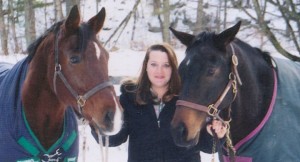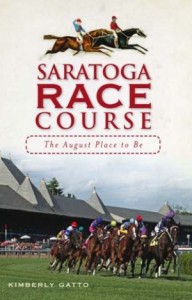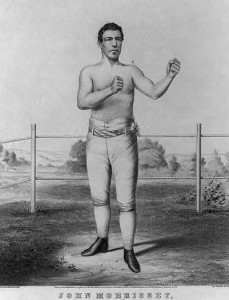When Off-TrackThoroughbreds.com first spoke with Kim Gatto, it was for a story about beautiful Grace. ([intlink id=”3143″ type=”post”]See related story[/intlink]).
Named after actress Grace Kelly, the Thoroughbred was languishing at the New Holland auction, and had attracted the attention of an eager meat buyer, when Gatto saved the mare. Gatto outbid the man by $10 and took home a Thoroughbred who, along with Gatto’s other important horses, would become bit of a muse for the lifelong equestrian and book author.
Over the years, Gatto has penned several equine related books, including Beyond the Rainbow Bridge: A Thoughtful Guide for Coping with the Loss of a Horse and An Apple a Day: A Heartwarming Collection of True Horse Stories. She has also contributed articles to The Chronicle of the Horse, Sidelines, and Blood-Horse. Most recently, the exciting world of horseracing has captured the author’s imagination, and resulted in her latest: Saratoga Race Course: The August Place to Be.
In the following Q&A interview, Gatto discusses her 9th book.
Q: Congratulations on your 9th published book! In writing about the “Spa” in Saratoga Race Course: The August Place to Be, what were some of the standout details of the track’s history that surprised and inspired you?
Thanks very much! There is so much interesting information about Saratoga; it was actually overwhelming to me at times. I was unable to include every interesting fact and stay within the word count assigned by my publisher, so I opted to include those that I felt were particularly interesting. For example, in its heyday, the track was a gathering place for all sorts of interesting personalities. The founder, John Morrissey, was a notorious character – bare knuckle boxing champion, self-proclaimed thief and mobster, gambler, and politician. He earned the nickname “Old Smoke” because he once fell onto some hot coals while in a brawl, and kept on fighting while smoke rose from his clothing!
While Morrissey did much of the work at establishing and operating the racecourse in its early years, he did not include his name on the legal documents, as he was never accepted into high society. Morrissey had friends in proverbial “high places” – men such as Cornelius “Commodore” Vanderbilt and William Travers – who helped to attract other wealthy socialites to the track. There were plenty of big spenders around at that time – Diamond Jim Brady, who supposedly ate enough for 10 men at a single meal; “Bet A Million” Gates, who won so much money on a single day that he had to carry it in a shopping basket; and William C. Whitney, who once bought champagne for everyone at the track after his horse won a big race. Whitney also is credited with saving the track when it fell into hard times after Morrissey’s death.
The most inspirational for me, however, were the horses. So many “long shots” have won at the Spa, upsetting the favorites and thus earning the track its famed nickname, “The Graveyard of Champions.” And so many horses showed incredible heart. One of the most inspiring for me was the mare Hidden Lake, who collapsed of dehydration immediately after winning the Go For Wand in 1997. Also, my favorite horse from childhood, Timely Writer, won the 1981 Hopeful Stakes at long odds in 1981. The list just goes on and on.
It was first referred to as “the Spa” due to its proximity to Saratoga’s mineral springs. Many wealthy folks would travel to the area to immerse themselves in the mineral waters during the summer months of July and August. It was a natural extension to build a casino and then a world-class racetrack nearby. John Morrissey felt that the men would gamble at the casino by night and relax at the track during the daytime while their wives enjoyed the mineral spas.
Many of these wealthy folks were involved in horseracing, either as owners or simply as bettors. From the beginning, the track drew the best thoroughbreds in the country. Saratoga’s list of winners includes the superstars of the sport throughout history, including the great Man o’ War (who also sustained his only defeat there) and Triple Crown champions War Admiral, Whirlaway, Secretariat, and Affirmed, among many, many others. To this day, it attracts the sport’s greatest horses, owners, and trainers.
Q: You’ve also written a history of Churchill Downs. Are there any other racetracks you hope to write about? And what inspired you to write about Saratoga?
I love history, so I find it really enjoyable to write about old racetracks. I am hoping that Belmont Park will be next. I would have liked to have written about the history of Del Mar (in California, co-founded by singer Bing Crosby), but a book on Del Mar’s history was done last year by another author. My friend Michael Blowen (of Old Friends) actually suggested that I write about Saratoga after I completed the book on Churchill Downs. Fortunately, my publisher loved the idea. To make it different from the many other books on Saratoga, I included some of the lesser-known horses who won races there, including several of the horses that now reside at Old Friends. In fact, the book is dedicated in memory of the great Black Tie Affair, who was originally purchased at the Saratoga Yearling Sales. I was fortunate to have met him at Old Friends before he passed away, and he made a lasting impression on me. I felt that it was only fitting to dedicate the book in his memory, and to donate proceeds to Old Friends.
Q: What is your opinion of the state of horseracing in general? Could you ever see the sport catching on again in America?
I am hoping that it does. Back in the day, horseracing was such a glamorous sport. It gave folks hope during the Depression and Wartime years when morale needed a serious boost. People could go to the track and escape their troubles, even if only for a day. Horses raced more frequently and for longer periods. Owners provided for their racehorses in retirement, often at their own farms. Unfortunately, I think our society now has a different mindset and people focus on the negative aspects of the sport. It is a fast-paced, “throwaway” society.
We need to return to that place in time where everything was simpler and more genuine. I think people get a sense of that when they go to Saratoga, as it still retains its “Old World” charm, and the idyllic setting provides some much-needed elegance and tranquility.
Q: You’ve been published extensively in equine publications and have authored several horse-related books. How did you get started in this work?
I always aspired to be a writer, even as a young child. I began writing poetry when I was six years old, and had several poems published when I was a teenager. After college, I began writing my first manuscript, which actually was never published. Around that time, I sent writing samples to a few publishers and was lucky enough to be offered a contract to write my first athlete biography. After that, I proposed an idea for an equestrian book with another publisher, which was also accepted.
Those were my first two books. Since then, I have been fortunate to work with several different publishers on both sports biographies and equine-related books. I have also written some articles for equine publications, but, due to the fact that I also work full-time (as a writer at a financial services company), it can be difficult to find the time to write as much as I’d like!





Congratulations Kimberly!! I have not had the pleasure of visiting Saratoga, as yet. However, from what I have read and have been told it is a page out of the past. A wonderful place to visit. Thank you, can’t wait to add your book to my treasured collection. Looking forward to your next project.
As always, thank you Susan! 🙂